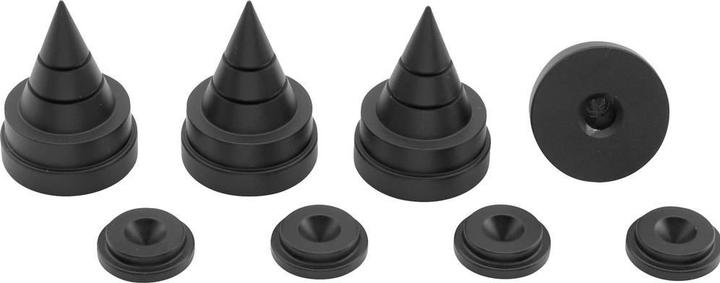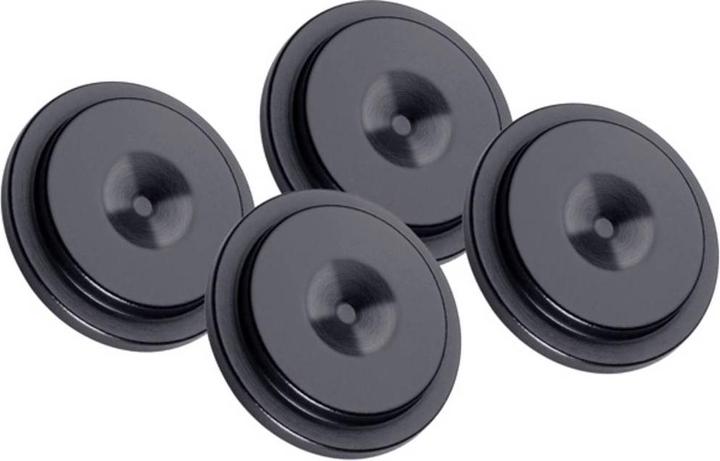

The art of positioning your loudspeakers
You have a premium Hi-Fi system and love to stream music and listen to CDs or LPs, but you’re not happy with the sound quality in your living room? Positioning your loudspeakers correctly can make a huge difference. Read on to find out how you can enjoy better sound without spending any (or much) money.
If you don’t only want to enjoy music with headphones, you’re likely to face one question: How to position the loudspeakers to make sure you can enjoy the best possible stereo sound quality in your home? The challenge is even tougher if you’re going for surround sound with five or more loudspeakers, but let’s stick with two for now. Positioning two speakers correctly is challenging enough.
I’m not going to bore your pants off with a long essay on the highly complex subject of room acoustics – let’s save that up for later. I’m also not going to talk about completely unrealistic ideas or recommend you spend a fortune on accessories. What I indent to do is show you the basics: How to get the best possible sound quality out of your Hi-Fi system and loudspeakers. My tips aim at achieving cleaner, dryer, less woolly bass, improved balance and representation of high frequencies as well as easier locatable instruments and vocals.
Stability
Let’s focus on dynamic loudspeakers. This covers 90% of the market. Dynamic loudspeakers are those with a baffle that’s equipped with one or more funnel-shaped drivers. Depending on the task they perform, they’re called woofers, mid-bass or mid-range drivers. The enclosure also includes the so-called dome tweeter, which has the shape of a hemisphere.
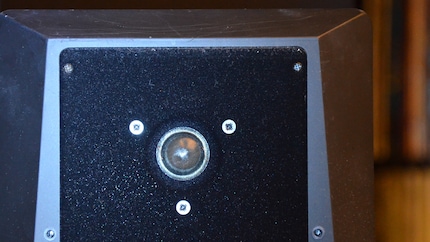
There are two types of Hi-Fi speakers: floorstanding speakers and compact or bookshelf speakers. They differ in size. The problem with most compact loudspeakers is that they’re not intended to be cramped into a shelve. They sound better when they’re free-standing. For this reason, you’ll need to get suitable stands if you want compact loudspeakers. Keep this in mind before you make a decision.
No matter if your speakers are on stands or on their own feet, make sure they stand in a solid way and don’t wobble. New models often come with rubber or plastic feet or pointed metal spikes that can be screwed on. It’s worth taking the time to attach them and position your loudspeakers in an accurate and level way. Use a spirit level to do so. Spikes are suitable for carpets and rugs while rubber or plastic feet are ideal for stone flooring, laminate or parquet. You’ve lost the spikes or feet of your speakers? Don’t worry. Buy underlays or self-adhesive window sealing tape – both are ideal for smooth flooring and make a surprisingly large difference.
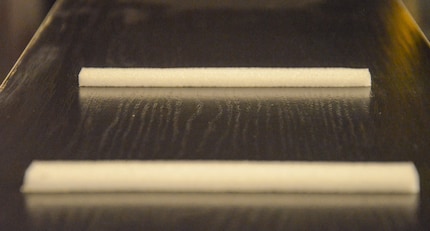
Space
Whether you have your speakers stand-mounted, on a shelf or wall-mounted, remember that speakers are generally designed to sound best if you leave space between the wall and the speaker. This is especially important for bass reflex systems, which have a port on the rear of the speaker. Leave at least 30 cm, better 60 cm, space between the speakers and the wall or corner they’re standing in front of. Of course, you don’t want to have two speakers in the middle of your living room. Try moving the speakers away from the walls 5 cm at a time until you find the ideal position. If this helps create crisper, cleaner bass and less echo, you’ve made great progress.
While the distance between the wall and the rear of the speaker needs to be identical for both speakers, this doesn’t apply to side walls. Au contraire; an asymmetrical position may even boost the sound quality that you’ve gained by moving the speakers away from the rear wall. However, the difference shouldn’t be too large. Uneven numbers are often better than straight-forward ones. Let’s say you’ve moved the speakers 60 cm from the real wall. Try positioning the left speaker 87 cm and the right one 137 cm from the side wall. It helped? This has to do with how certain frequencies (pitches) escalate in the room. With even proportions, the escalation is lower. This applies to the loudspeakers as well as the room itself. Following the spirit level mentioned earlier, a tape measure is the second handy gadget. If you want to take things even further, there are test CDs with moving sine waves (sweeps) that help you check and optimise the positioning of your speakers. These CDs are extremely helpful and are available for less than 50 francs. Some test magazines even include a free version. If you don’t want to spend any money, try experimenting with bass-heavy music (big organ, techno, hip-hop).
Positioning
Our ears are extremely sensitive when it comes to minimal acoustic differences that can be caused by the room and the positioning of the speakers. If two sound events reach the listener’s ears simultaneously (as is usual for stereo listening), a time difference of just 40 microseconds (or 1/2500 second!) between the two can result in a different impression of space and location. The human sense of hearing is constantly trying to calculate a consistent picture of the environment from the incoming sound waves, in order to get an idea of the size of the room, the nature of the environment and – most of all – the directions of the incoming sounds.
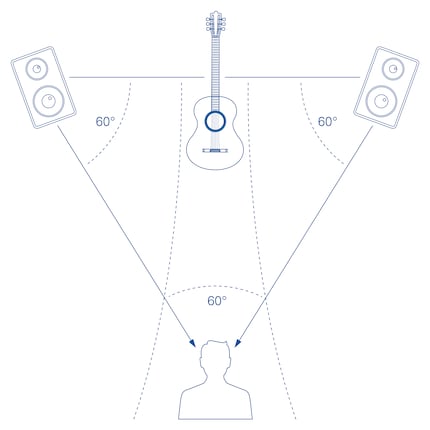
To put it simple: If possible, make sure that your preferred listening position and the speakers form an isosceles triangle. See the triangle in the image above? You should sit as closely as possible at the top of this triangle. Take your favourite CD, if possible one with vocals, and listen to the sound as it can be heard in the middle between the speakers. Of course, only if the vocals are optimised accordingly. To check this, listen to the same song with headphones and observe if the vocals seem to come from the centre. Now, adjust the angle of the loudspeakers. Begin in a parallel position to the rear wall and turn them little by little, until the tweeter domes «aim» directly at your eyes. If the speakers have removable protective grilles or screens, take them off and shine a powerful torch right at the middle between the speakers. If the light from both sides is reflected exactly in the centre of the dome, you’ve found the angle that reflects sound directly at your ears. Remember the angle where the mid-image sounded best to you and where the high-pitched notes didn't seem too shrill.
You’ve nailed the positioning of your speakers, but are still unhappy with the sound? You might need
more elaborate measures. In general, large, smooth and hard surfaces are the enemy of good sound. Soft, perforated surfaces, which don’t reflect sound waves as much and disperse them in all directions, promote neutral sound reproduction. Try hanging thick curtains in front of windows or balcony doors and placing a carpet on a stone floor. Shelves that are filled with books and upholstered furniture also helps. Even placing large plants in the right spots can have a positive effect on the sound quality.
Yet, before you rearrange your entire home, try the simple tricks I described above. I’m sure they’ll improve the performance of your loudspeakers and allow you to enjoy your sound system and music that little bit more.
Cover picture: Thomas Kunz
I have been a journalist in the audio industry for over 30 years. I have a reputation as an avid music lover, a die-hard analog fan and an uncompromising critic of speakers. This surely has something to do with my lamentable attempts to play violin and drums beyond amateur status. For a while I lived and worked in Switzerland, my favorite country, where I love to return.
Interesting facts about products, behind-the-scenes looks at manufacturers and deep-dives on interesting people.
Show all
